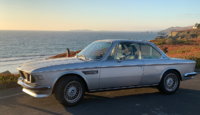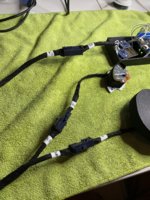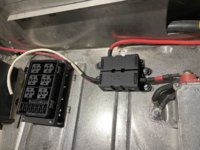Last week was a terrific week of progress on our "Phase One" completion (AKA- buttoning up the car enough to bring it home and enjoy it for 6-12 months before stripping her back down for final paint and finish).
Sound Deadening- We sprayed topcoat to the inner doors and floors then applied DynaMat to the entire surfaces. I'd say it's around 40lbs worth, but completely worth the weight and effort. The feel of the car is so tight now, which is dramatic when driving. Our custom seat mounts look much more finished painted and poking through the material. We will wrap up this work next week.



Digital Dash Display- A few weeks ago I posted the progress of physically mounting the color digital dash display. With a lot of perseverance with video scaling, and nice work from Jeff on Raspberry Pi programming, I was able to finally get the mounted display to show our live information from the Tesla unit. There is some fine-tuning to be done, but it's just about there. The photo makes it look like it is brighter than the other gauges, but in real life, it blends in far better than I had even hoped. Very excited for how this came out. Currently I am working on converting the Speedo, Temp and Fuel gauges to Stepper motor control so that we can have the classic gauges telling the modern information.

Dash Work - I wouldn't be able to bring the car within 10 miles of home with the dash looking like this:

I came across a guy on eBay who was amazingly local who had purchased a set of Leather wraps for an E9 dash- but then had sold his car before installing them (buying the parts is always the easy part Remember that I am using E93 leather seats, so I took a bunch of photos of my seats and met the guy to see if the leather would match.
Remember that I am using E93 leather seats, so I took a bunch of photos of my seats and met the guy to see if the leather would match.
It must have been my lucky day, because it was perfect. When I brought them back to the car I can't tell them apart. The funny thing is my upholstery guy can't find as close of match in all his sample books And the stitching is the same as well. I picked it up for a couple hundred bucks.
And the stitching is the same as well. I picked it up for a couple hundred bucks.

Of course my Upholsterer wasn't quite that cheap, but he is my neighbor where my shop is and he was very kind to me. They had to first do a lot of repair to the dash. The instrument section was split open to twice it's thickness where it meets the wood. One of the mounting screws was broken off, and cracks everywhere. They did an amazing job at the repairs, then a wonderful job at the wrapping.



To celebrate the efforts we took the car out for our longest drive yet. Much further away than we could push her home if she broke down, that's for sure We drove to Norms and got lunch- the first day that restaurants were open in California! Then we took her for a 25 minute drive along the So Cal freeways. The car felt terrific at 80MPH and on the high-speed ramps. Can't wait to do more of that. It's probably the quickest E9 that's ever been on the road, but who's keeping score
We drove to Norms and got lunch- the first day that restaurants were open in California! Then we took her for a 25 minute drive along the So Cal freeways. The car felt terrific at 80MPH and on the high-speed ramps. Can't wait to do more of that. It's probably the quickest E9 that's ever been on the road, but who's keeping score . It's certainly the stealthiest, since it is perfectly silent when getting up to speed in a few seconds. It is completely well-behaved too.
. It's certainly the stealthiest, since it is perfectly silent when getting up to speed in a few seconds. It is completely well-behaved too.
I know that a lot of enthusiasts feel what without the engine noise or running through gears that there is no real joy in driving. But, as we all know, old cars are very fun to drive "for a while". At the end of a weekend rally, you are ready to get back into your modern car. I think what we have here is something that provides a lot of enjoyment, turns heads with it's form, and is still easy for this old guy to drive day after day. (I'll keep convincing myself


All in all, it's been a very exciting week, and I might be just a few weeks away from bringing the car home and driving it to work most days!
Sound Deadening- We sprayed topcoat to the inner doors and floors then applied DynaMat to the entire surfaces. I'd say it's around 40lbs worth, but completely worth the weight and effort. The feel of the car is so tight now, which is dramatic when driving. Our custom seat mounts look much more finished painted and poking through the material. We will wrap up this work next week.
Digital Dash Display- A few weeks ago I posted the progress of physically mounting the color digital dash display. With a lot of perseverance with video scaling, and nice work from Jeff on Raspberry Pi programming, I was able to finally get the mounted display to show our live information from the Tesla unit. There is some fine-tuning to be done, but it's just about there. The photo makes it look like it is brighter than the other gauges, but in real life, it blends in far better than I had even hoped. Very excited for how this came out. Currently I am working on converting the Speedo, Temp and Fuel gauges to Stepper motor control so that we can have the classic gauges telling the modern information.
Dash Work - I wouldn't be able to bring the car within 10 miles of home with the dash looking like this:
I came across a guy on eBay who was amazingly local who had purchased a set of Leather wraps for an E9 dash- but then had sold his car before installing them (buying the parts is always the easy part
It must have been my lucky day, because it was perfect. When I brought them back to the car I can't tell them apart. The funny thing is my upholstery guy can't find as close of match in all his sample books
Of course my Upholsterer wasn't quite that cheap, but he is my neighbor where my shop is and he was very kind to me. They had to first do a lot of repair to the dash. The instrument section was split open to twice it's thickness where it meets the wood. One of the mounting screws was broken off, and cracks everywhere. They did an amazing job at the repairs, then a wonderful job at the wrapping.
To celebrate the efforts we took the car out for our longest drive yet. Much further away than we could push her home if she broke down, that's for sure
I know that a lot of enthusiasts feel what without the engine noise or running through gears that there is no real joy in driving. But, as we all know, old cars are very fun to drive "for a while". At the end of a weekend rally, you are ready to get back into your modern car. I think what we have here is something that provides a lot of enjoyment, turns heads with it's form, and is still easy for this old guy to drive day after day. (I'll keep convincing myself
All in all, it's been a very exciting week, and I might be just a few weeks away from bringing the car home and driving it to work most days!



